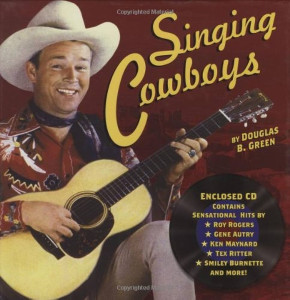 Singing Cowboys! Just picture them, all dressed in their flashy Nudie shirts, plunking on a Martin D-45, perched on their faithful palomino or roan, singing their hearts out to the beautiful daughter of the local ranch owner. Gene Autry, or Roy Rogers spring immediately to mind. But Douglas B. Green (better known as Ranger Doug from the Riders In the Sky) has collected an impressive number of lesser known western warblers in his new book entitled Singing Cowboys.
Singing Cowboys! Just picture them, all dressed in their flashy Nudie shirts, plunking on a Martin D-45, perched on their faithful palomino or roan, singing their hearts out to the beautiful daughter of the local ranch owner. Gene Autry, or Roy Rogers spring immediately to mind. But Douglas B. Green (better known as Ranger Doug from the Riders In the Sky) has collected an impressive number of lesser known western warblers in his new book entitled Singing Cowboys.
The book is packed with brief biographies, and photos of the stars, posters from the films and copies of songsheets. It’s a rich tribute to these tuneful troubadors of the tumbleweeds. Rex Allen (whose resonant voice is well known to any fans of Walt Disney’s nature films – Mr. Allen narrated most of them) is the first entry. He was the “last one signed to star in a singing series [by] Republic Pictures” and was known as the”Last of the Singing Cowboys.” He is followed by Gene Austin, who sold millions of records in the ’20s before becoming a nightclub owner. When offered a role as a singing cowboy, he “. . .sold the club at a good profit, and went on a crash reducing diet so that [his] seat would fit the seat of the saddle, and plunged into a rigorous schedule for the role.” And you thought it was easy! Don’t confuse Mr. Austin with Mr. Autry! Gene Autry gets four times the coverage allotted to Gene Austin. He (with his horse Champion) was perhaps the most important of all the vocalizing vaqueros! He sold more records than any other of the crooning cowpokes managed to do. He crossed over from films to radio and to television. He was a personal favourite of mine, and today I still have a mug from the Gene Autry Museum on my desk.
Ken Curtis, who had a memorable turn in the classic western film The Searchers (and was later to play sidekick Festus Haggen on Gunsmoke) is here, Smiley Burnette, Tex Fletcher, Tito Guizar and even Bing Crosby get a mention. BING CROSBY? Yep! He played a cowboy in 1936’s Rhythm on the Range! They tried to make John Wayne into a sagebrush strummer, but his voice was dubbed, and the Duke refused to do that again because he was “just so [bleep]ing embarrassed by it all. Strumming a guitar I couldn’t play and miming to a voice which was provided by a real singer made me feel like a [bleep]ing pansy.” Can’t say that I blame you, Duke!
The singing groups like the Riders of the Purple Sage or the Sons of the Pioneers are awarded a few pages each. It was as a “son of the pioneer” that Len Slye got his start. If you don’t recognize that name, try Dick Weston. No? How about Roy Rogers? Does he ring a bell? His career took off when Republic Pictures needed a replacement for Gene Autry (when he “left the lot in one of his frequest contract disputes.”)
Douglas B. Green has compiled a beauty of a book here. If you have any interest in the era, or subject at all Singing Cowboys is a treasure trove of trivia and memorabilia. And it has a CD too! So you can listen to 10 of the greats as you peruse the pages. Aah . . . memories!
(Gibbs Smith, 2006)
